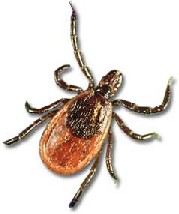|
|
 Lyme Disease is the most recognized of the tick-borne
illnesses. The disease is transmitted by ticks who have fed
on certain deer and mice. These ticks are found throughout
the United States. The peak tick season is May though
September. The areas of highest risk are the Northeast ,
Great Lakes Region, and an area in Northern California. Current scientific
estimates indicate that the disease is transmitted after the tick has attached to
the individual for 6 to 24 hours. Between 15 and 30 percent
of the
ticks are infected. The longer the tick is attached, the
greater the probability of infection.
Lyme Disease is the most recognized of the tick-borne
illnesses. The disease is transmitted by ticks who have fed
on certain deer and mice. These ticks are found throughout
the United States. The peak tick season is May though
September. The areas of highest risk are the Northeast ,
Great Lakes Region, and an area in Northern California. Current scientific
estimates indicate that the disease is transmitted after the tick has attached to
the individual for 6 to 24 hours. Between 15 and 30 percent
of the
ticks are infected. The longer the tick is attached, the
greater the probability of infection.
Early Signs and Symptoms (three to 32 days after tick bite)
- Characteristic "bulls-eye" (red,
circular) rash at the site of the tick bite. Most common
sites are scalp, groin, and armpits.
- Fever
- Headache
- Fatigue (feeling tired)
- Muscle and joint pain
- Swollen glands
Later Signs and Symptoms (six to nine months after tick
bite)
- Weak facial muscles
- Stiff neck
- Irregular heart beat
- Numbness
- Shills loss of appetite
- Dizziness
- Persistent fatigue (feeling tired)
- Double vision
For more information about Lyme disease go to The Lyme Disease Association
website (http://lymediseaseassociation.org).
|
|

|
|
|
|
- Babesiosis is transmitted by ticks that typically have been infected by rodents, cattle, or wild animals. These ticks are most commonly found in the Northeastern, Pacific Coast, and
Upper Midwestern portions of the United States.
Signs and Symptoms: (begin one to nine weeks after tick bite)
- Fever
- Chills
- Sweating (profuse)
- Fatigue (feeling tired)
- Dark-colored urine
- Nausea (sick to stomach)
- Abdominal pain
- Low blood count
- Enlarged spleen
|
|

|
|
|
|
- Ehrlichiosis is transmitted by deer ticks and the Lone Star tick. Peak cases are from
May to July and October to December. The first known cases were described in 1987. Reported incidences have occurred in individuals over 40 years old. The most prevalent areas of the country are the Southern and Northeastern areas of the United States.
Early Signs and Symptoms (five to 11 days after tick bite)
- Rapid onset of fever
- Acute headache
- Non-specific rash (usually lower part of body)
- Shaking chills
- Generalized tired feeling
- Muscle and joint pain
- Cough
- Vomiting
Individuals can become very sick, with up to 54
percent hospitalized.
|
|

|
|
|
|
- Another tick-borne illness transmitted by the American dog tick and the Rocky Mountain wood tick. The states with the highest incidence of the illness are North Carolina and Oklahoma. Fifty percent of the infections occur in the South-Atlantic region of the United States. The Pacific
and West-South Central regions also have cases. More than 90 percent of the patients with Rocky Mountain Spotted Fever are infected between April and September.
Early Signs and Symptoms (three to four days after the bite)
- Fever
- Nausea (feeling sick to stomach)
- Severe headache
- Muscle pain
- Lack of appetite
Later Signs and Symptoms
- Rash (wrists, forearms and ankles)
- Abdominal pain
- Joint pain
- Diarrhea
|
|

|
|
|
|
- Encourage workers to wear light-colored clothing so
ticks can be spotted easily.
- Wear long-sleeved shirts and long pants.
- Tuck pant legs into high boots. Tape area where pants and socks meet.
- Wear hats.
- Spray clothing and skin with repellants.
Use Permethrin for the clothes and DEET for the skin.
- Wash clothes in high temperatures after working outdoors.
- Examine skin closely for ticks.
- If tick present, carefully grasp the tick as close to the skin as possible and pull straight out, without twisting.
- Place the tick in a closed container and take it to a local health department for identification.
Wash the bite area with soap and water.
|
|

|
|
|
